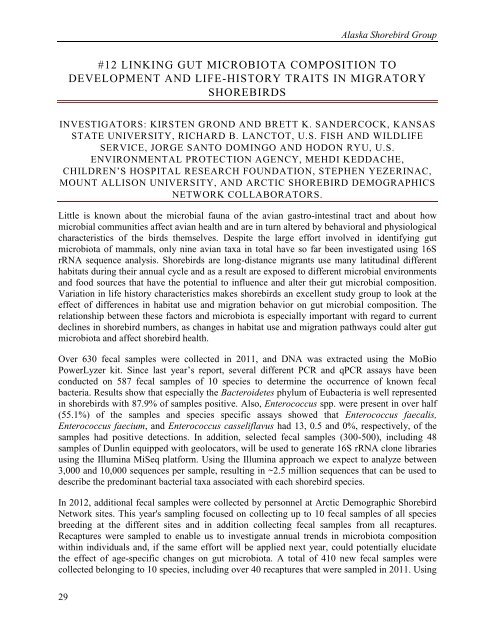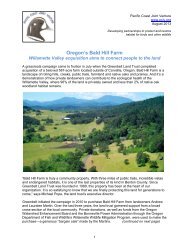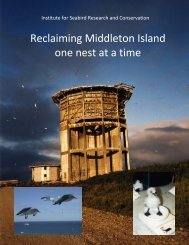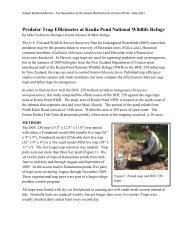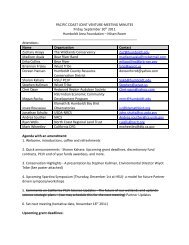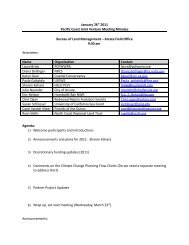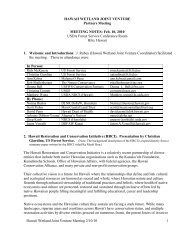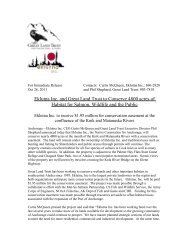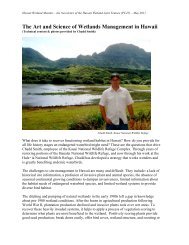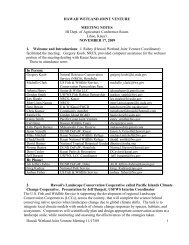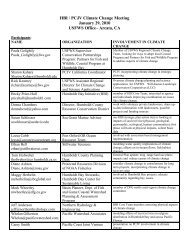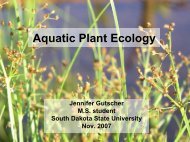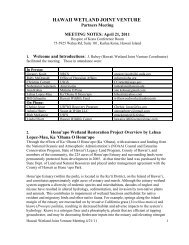Alaska Shorebird Group Annual Summary Compilation
Alaska Shorebird Group Annual Summary Compilation
Alaska Shorebird Group Annual Summary Compilation
You also want an ePaper? Increase the reach of your titles
YUMPU automatically turns print PDFs into web optimized ePapers that Google loves.
<strong>Alaska</strong> <strong>Shorebird</strong> <strong>Group</strong>#12 LINKING GUT MICROBIOTA COMPOSITION TODEVELOPMENT AND LIFE-HISTORY TRAITS IN MIGRATORYSHOREBIRDSINVESTIGATORS: KIRSTEN GROND AND BRETT K. SANDERCOCK, KANSASSTATE UNIVERSITY, RICHARD B. LANCTOT, U.S. FISH AND WILDLIFESERVICE, JORGE SANTO DOMINGO AND HODON RYU, U.S.ENVIRONMENTAL PROTECTION AGENCY, MEHDI KEDDACHE,CHILDREN’S HOSPITAL RESEARCH FOUNDATION, STEPHEN YEZERINAC,MOUNT ALLISON UNIVERSITY, AND ARCTIC SHOREBIRD DEMOGRAPHICSNETWORK COLLABORATORS.Little is known about the microbial fauna of the avian gastro-intestinal tract and about howmicrobial communities affect avian health and are in turn altered by behavioral and physiologicalcharacteristics of the birds themselves. Despite the large effort involved in identifying gutmicrobiota of mammals, only nine avian taxa in total have so far been investigated using 16SrRNA sequence analysis. <strong>Shorebird</strong>s are long-distance migrants use many latitudinal differenthabitats during their annual cycle and as a result are exposed to different microbial environmentsand food sources that have the potential to influence and alter their gut microbial composition.Variation in life history characteristics makes shorebirds an excellent study group to look at theeffect of differences in habitat use and migration behavior on gut microbial composition. Therelationship between these factors and microbiota is especially important with regard to currentdeclines in shorebird numbers, as changes in habitat use and migration pathways could alter gutmicrobiota and affect shorebird health.Over 630 fecal samples were collected in 2011, and DNA was extracted using the MoBioPowerLyzer kit. Since last year’s report, several different PCR and qPCR assays have beenconducted on 587 fecal samples of 10 species to determine the occurrence of known fecalbacteria. Results show that especially the Bacteroidetes phylum of Eubacteria is well representedin shorebirds with 87.9% of samples positive. Also, Enterococcus spp. were present in over half(55.1%) of the samples and species specific assays showed that Enterococcus faecalis,Enterococcus faecium, and Enterococcus casseliflavus had 13, 0.5 and 0%, respectively, of thesamples had positive detections. In addition, selected fecal samples (300-500), including 48samples of Dunlin equipped with geolocators, will be used to generate 16S rRNA clone librariesusing the Illumina MiSeq platform. Using the Illumina approach we expect to analyze between3,000 and 10,000 sequences per sample, resulting in ~2.5 million sequences that can be used todescribe the predominant bacterial taxa associated with each shorebird species.In 2012, additional fecal samples were collected by personnel at Arctic Demographic <strong>Shorebird</strong>Network sites. This year's sampling focused on collecting up to 10 fecal samples of all speciesbreeding at the different sites and in addition collecting fecal samples from all recaptures.Recaptures were sampled to enable us to investigate annual trends in microbiota compositionwithin individuals and, if the same effort will be applied next year, could potentially elucidatethe effect of age-specific changes on gut microbiota. A total of 410 new fecal samples werecollected belonging to 10 species, including over 40 recaptures that were sampled in 2011. Using29


